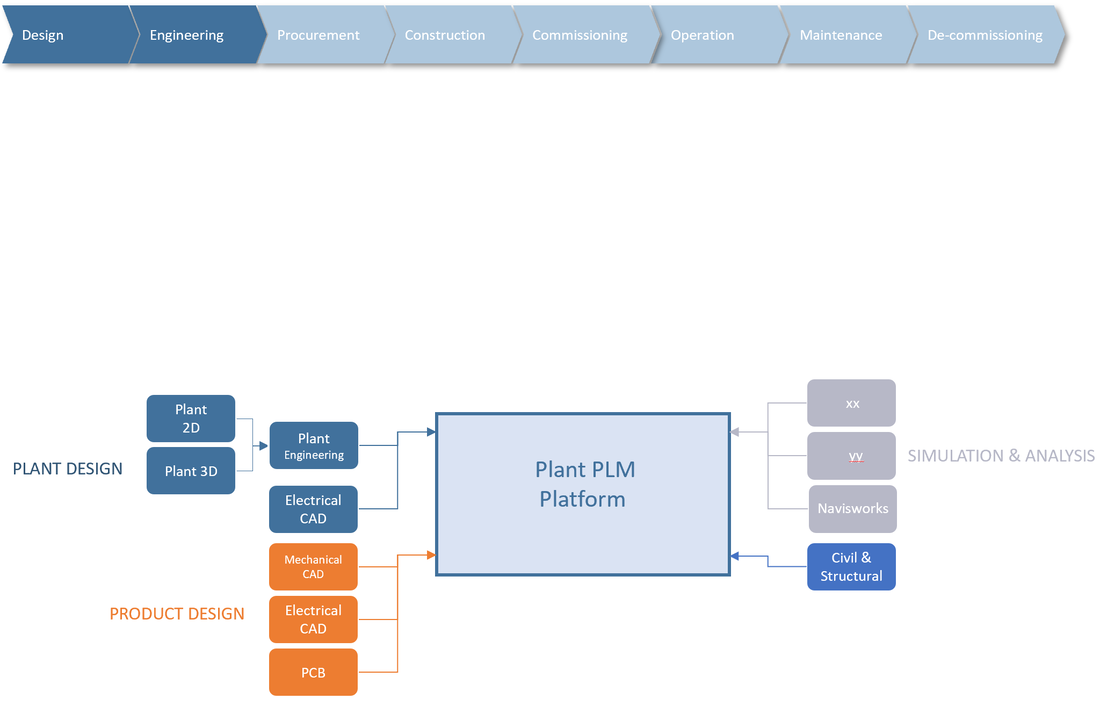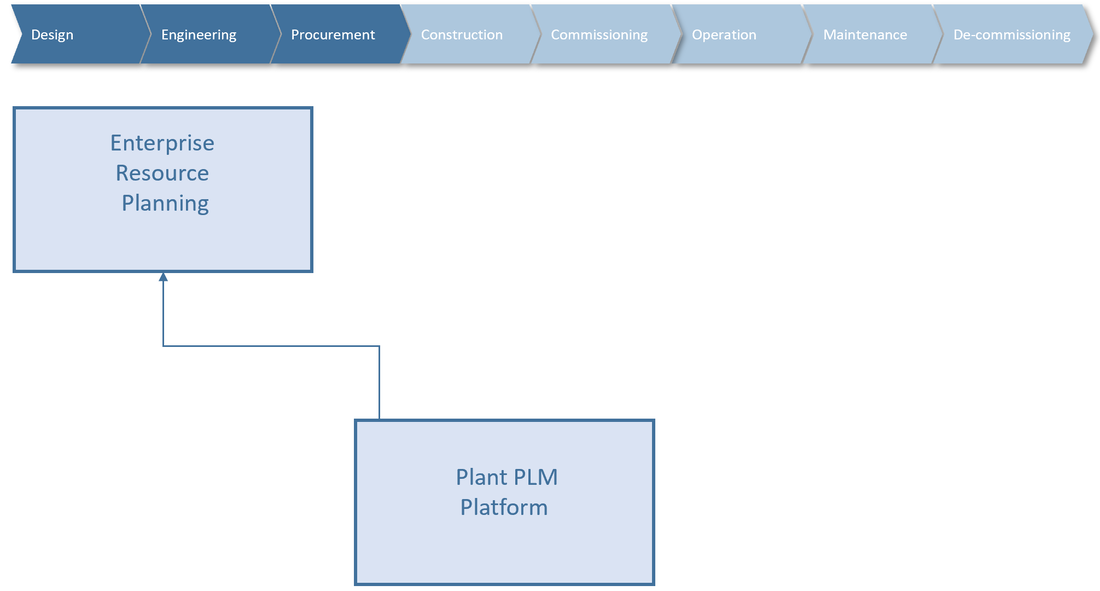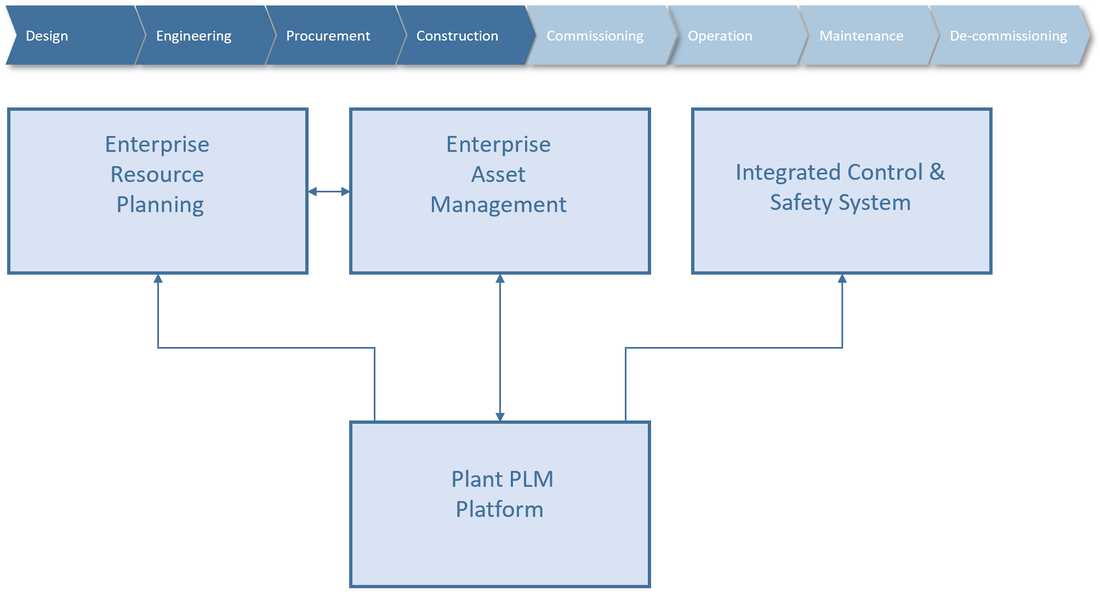In these two articles I’ll try to explain why and how a data flow approach between main systems during a plants lifecycle is far more effective than a document based handover process between project phases. I have earlier discussed the various information structures that needs to be in place across the same lifecycle. If you’re interested the list of articles is found at the end of this article.
During design and engineering the different plant and product design disciplines authoring tools play a major role as they are feeder systems to the Plant PLM Platform. All the information coming from these tools needs to be consolidated, managed and put under change control. The Plant PLM Platform also plays a major role to document the technical baselines of the plant, such as As-Designed, As-Built, As-Commissioned and As-Maintained. See figure 1.
During design and engineering the different plant and product design disciplines authoring tools play a major role as they are feeder systems to the Plant PLM Platform. All the information coming from these tools needs to be consolidated, managed and put under change control. The Plant PLM Platform also plays a major role to document the technical baselines of the plant, such as As-Designed, As-Built, As-Commissioned and As-Maintained. See figure 1.
Figure 1.
When moving into the procurement phase, a lot of information needs to flow to the ERP system for purchasing of everything needed to construct the plant. The first information that must be transferred is released product designs, so Engineering Bill Of Materials. This is the traditional Product Lifecycle Management domain. The released EBOM says that seen from product engineering everything is ready for manufacturing and ERP can start procuring parts and materials to manufacture the product. Depending on the level of product engineering done in the plant project this can be a lot or just individual parts representing standard components or standard Parts.
The next information that needs to go to ERP is released tag information where the tag is connected to a released part. Here a typical example would be that a piping system is released with let’s say 8 pump tags and the pumps individual requirements in the system can all be satisfied by a generic part from a manufacturer. This would mean that in the Plant PLM system there are 8 pump tag objects that are released and they are all connected to the same generic released part. This constitutes a validated project specific demand for 8 pumps. At this stage an As-Designed baseline can be created in the Plant PLM platform for that particular system.
This information must be transferred to ERP where it now means that procurement should place an order for 8 pumps and manage the logistics around this. However, seen from Project planning and execution it might be identified that according to the project execution plan several other systems are scheduled for release shortly which would make the order 50 pumps instead of 8. After communicating with affected stakeholders, it may be that it is decided to defer the order.
When moving into the procurement phase, a lot of information needs to flow to the ERP system for purchasing of everything needed to construct the plant. The first information that must be transferred is released product designs, so Engineering Bill Of Materials. This is the traditional Product Lifecycle Management domain. The released EBOM says that seen from product engineering everything is ready for manufacturing and ERP can start procuring parts and materials to manufacture the product. Depending on the level of product engineering done in the plant project this can be a lot or just individual parts representing standard components or standard Parts.
The next information that needs to go to ERP is released tag information where the tag is connected to a released part. Here a typical example would be that a piping system is released with let’s say 8 pump tags and the pumps individual requirements in the system can all be satisfied by a generic part from a manufacturer. This would mean that in the Plant PLM system there are 8 pump tag objects that are released and they are all connected to the same generic released part. This constitutes a validated project specific demand for 8 pumps. At this stage an As-Designed baseline can be created in the Plant PLM platform for that particular system.
This information must be transferred to ERP where it now means that procurement should place an order for 8 pumps and manage the logistics around this. However, seen from Project planning and execution it might be identified that according to the project execution plan several other systems are scheduled for release shortly which would make the order 50 pumps instead of 8. After communicating with affected stakeholders, it may be that it is decided to defer the order.
Figure 2
As the order is placed together with information regarding each specific Tag requirement, preparation for goods receival, intermediate storage and work orders for installation must be made. This is normally done in an Enterprise Asset Management (EAM) system which also needs to be aware of the Tag’s and their requirements, physical locations to install the arrived pumps and what corresponding part definition the received physical asset is representing. All of this information is fed to the EAM system from the Plant PLM platform. As the physical assets are received, each of our now 50 pumps needs to be inspected, logged in the EAM system together with the information provided by the vendor and associated with the common part definition. If the pumps are scheduled for immediate installation, each delivered physical asset is Tagged as they now are installed to fulfill a dedicated function in the plant.
At this stage the information about the physical asset and its relations to Tag, physical location, and corresponding part is sent back to the Plant PLM platform for consolidation. This step is crucial if a consolidated As-Built baseline is needed and there is a need to compare As-Designed with As-Built. Alternately the EAM system needs to “own” the baselines.
As the order is placed together with information regarding each specific Tag requirement, preparation for goods receival, intermediate storage and work orders for installation must be made. This is normally done in an Enterprise Asset Management (EAM) system which also needs to be aware of the Tag’s and their requirements, physical locations to install the arrived pumps and what corresponding part definition the received physical asset is representing. All of this information is fed to the EAM system from the Plant PLM platform. As the physical assets are received, each of our now 50 pumps needs to be inspected, logged in the EAM system together with the information provided by the vendor and associated with the common part definition. If the pumps are scheduled for immediate installation, each delivered physical asset is Tagged as they now are installed to fulfill a dedicated function in the plant.
At this stage the information about the physical asset and its relations to Tag, physical location, and corresponding part is sent back to the Plant PLM platform for consolidation. This step is crucial if a consolidated As-Built baseline is needed and there is a need to compare As-Designed with As-Built. Alternately the EAM system needs to “own” the baselines.
Figure 3.
The next step is to make the Integrated Control & Safety system aware of the installed assets, and this will be among the topics for the next article.
If you want to know more about what kind of information structures and data that needs to be consolidated and flow between the systems, you can find more information here:
Plant Information Management - Information Structures
Archive of articles
Bjorn Fidjeland
The header image used in this post is by Wavebreakmedia Ltd and purchased at dreamstime.com
The next step is to make the Integrated Control & Safety system aware of the installed assets, and this will be among the topics for the next article.
If you want to know more about what kind of information structures and data that needs to be consolidated and flow between the systems, you can find more information here:
Plant Information Management - Information Structures
Archive of articles
Bjorn Fidjeland
The header image used in this post is by Wavebreakmedia Ltd and purchased at dreamstime.com





 RSS Feed
RSS Feed
